Hanoi is the capital of Vietnam, a city rich in history, culture, and cuisine, located in northern Vietnam with four distinct seasons.
Hanoi is known for its vibrant streets, culture, historical sites, and delicious food. Whether you are a frequent visitor or it’s your first time in Hanoi, the city will offer amazing experiences for your travel journey, from simple activities like strolling around or enjoying a bowl of pho by the lake, to countless ways to explore the city’s charming beauty.
Due to Hanoi’s cultural and historical appeal, questions often arise, such as whether 2 or 3 days are enough to visit Hanoi, which are the most beautiful places to visit in Hanoi, what Hanoi is famous for, and what should be avoided in Hanoi. In this article, we will guide you through 18 amazing things to do in Hanoi. By following our list step-by-step, you will gain a deeper understanding of Hanoi’s history, culture, cuisine, and its people, and this visit will be a memorable part of your travel experiences
Editor’s note: This article was last updated in October 2024 to ensure the information remains current and useful for readers
1. Admire the Flag-Raising Ceremony at Ho Chi Minh Mausoleum
Start your day with the flag-raising ceremony at the Ho Chi Minh Mausoleum is one of the amazing things to do in Hanoi, a significant symbol of Vietnam’s respect for its founding father. Located in Ba Dinh Square, the mausoleum is at 2 Hung Vuong Street, Dien Bien Ward, Ba Dinh District, Hanoi. This is where President Ho Chi Minh, the leader who declared Vietnam’s independence in 1945, rests. His embalmed body is preserved here for the public to pay their respects.
The mausoleum was built between 1973 and 1975, is modeled after Lenin’s mausoleum in Moscow, reflecting a blend of Vietnamese and Soviet architectural styles. It stands as a place for national remembrance and patriotism.
The flag-raising ceremony starts at 6:00 AM in the summer (April to October) and 6:30 AM in the winter (November to March). This solemn ceremony is conducted by the Vietnam Honor Guard in full dress uniform, drawing visitors and locals alike.
If you want to visit inside, you are expected to follow strict rules: dress modestly, no hats, sunglasses, or phones are allowed inside. Silence must be maintained, and photography is not permitted inside the mausoleum. These guidelines are in place to honor the sanctity of this historical site. A visit to this landmark offers a powerful connection to Vietnam’s past and cultural pride.
2. Try Authentic Pho and Banh Mi – National Dishes of Vietnam
Pho and Banh Mi are two iconic dishes you can’t miss in Hanoi. Pho is a flavorful noodle soup made with flat rice noodles, typically served with beef (Pho Bo) or chicken (Pho Ga). The broth is the feature of pho, simmered for many hours with beef bones and spices like star anise, cinnamon, and cloves, along with onion and ginger. It’s garnished with fresh herbs, lime, chili, and bean sprouts. For an authentic experience, visit Pho Gia Truyen on Bat Dan Street, a renowned spot for its rich, fragrant broth and perfectly cooked noodles.
Banh Mi, on the other hand, is a Vietnamese sandwich made from a crispy French baguette stuffed with a variety of ingredients. Common fillings include pate, pork, grilled chicken, or beef, along with pickled carrots, cucumber, cilantro, and a drizzle of soy or chili sauce. The combination of textures and flavors makes Banh Mi a delightful, quick meal. You can enjoy the best version at Banh Mi 25, a popular street stall famous for its freshly baked baguettes and flavorful fillings.
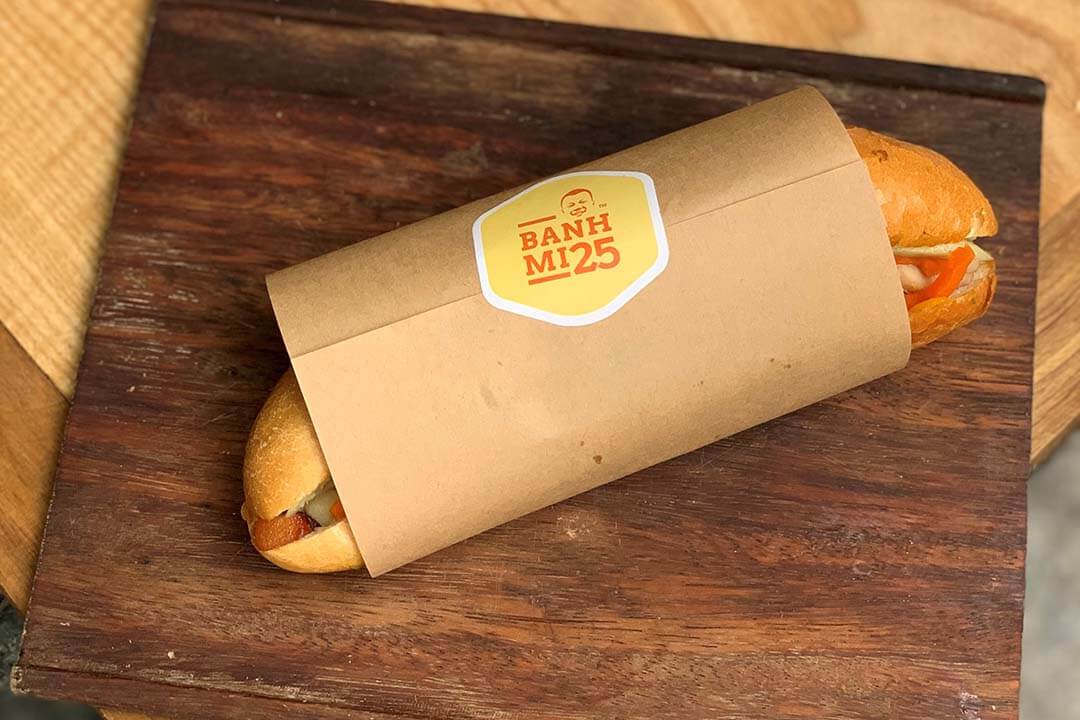
Both dishes are incredibly affordable: Banh Mi costs around $1, and Pho is about $2. These are quintessential parts of Hanoi’s street food culture, providing a delicious taste of Vietnam’s culinary heritage.
3. Drink Egg Coffee or Milk Coffee
Hanoi is famous for its rich coffee culture, and two must-try beverages are Egg Coffee and Milk Coffee.
Egg Coffee is a unique Hanoi specialty, first created in the 1940s due to a shortage of milk. It’s made by whisking egg yolks with sugar, condensed milk, and coffee to create a frothy, creamy mixture. The result is a rich, velvety coffee with a texture similar to custard. The coffee base is typically brewed using strong Vietnamese drip coffee, making it a warm, indulgent treat. You can enjoy this signature drink at iconic spots like Giang Café, where it was invented.
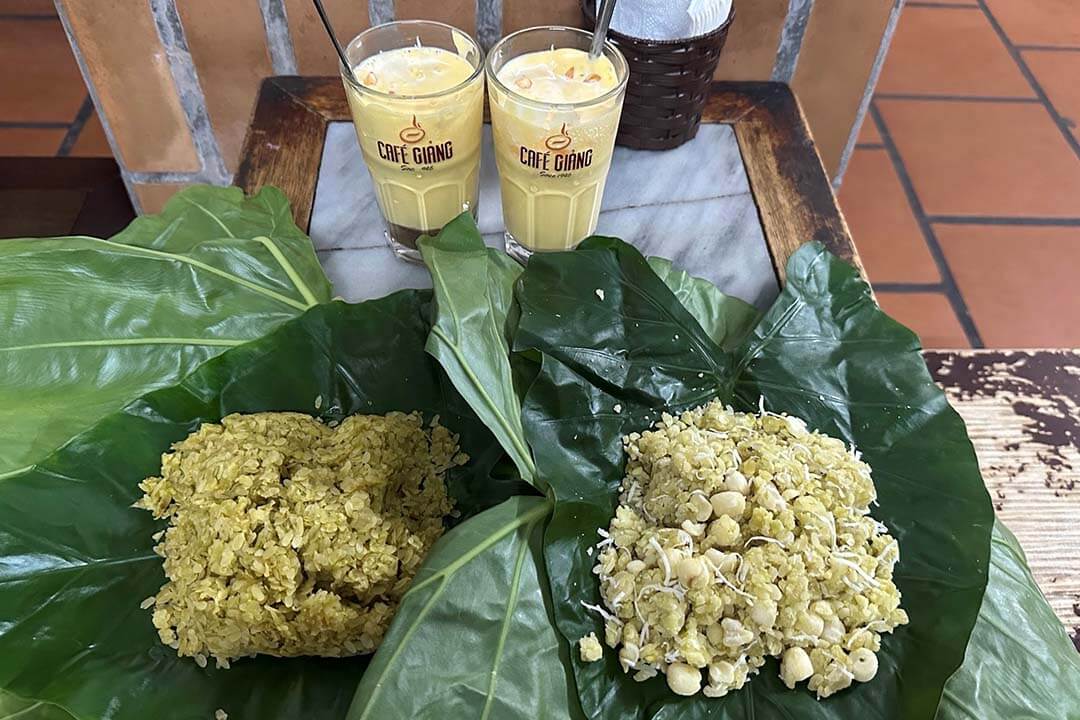
Milk Coffee (Cà phê sữa), on the other hand, is a more traditional Vietnamese coffee. It consists of robust Vietnamese dark roast coffee brewed through a metal drip filter (phin) and sweetened with condensed milk. The coffee is strong, rich, and sweet, offering a perfect balance of flavors. Served either hot or iced, it’s a staple drink across Vietnam.
For the best coffee experience, visit Hidden Gem Cafe Hanoi, a popular spot with cozy ambiance and excellent coffee. Both Egg Coffee and Milk Coffee are highly affordable, with prices ranging from $1 to $2. These delicious beverages are a perfect way to experience Hanoi’s vibrant coffee scene.
4. Walk or Cycle Around Hoan Kiem Lake
Located in the heart of Hanoi (Hang Trong, Hoan Kiem District, Hanoi), Hoan Kiem Lake is a peaceful oasis surrounded by bustling streets. The lake holds a special place in the hearts of locals due to its deep connection to Vietnamese history and folklore.
According to legend, in the 15th century, Emperor Le Loi was given a magical sword by the gods to help him defeat foreign invaders. After the war, while boating on the lake, a giant turtle emerged and took the sword, returning it to the divine realm. The lake was thus named Hoan Kiem, meaning “Lake of the Returned Sword.” Spanning an area of 12 hectares, the lake is a historical and cultural symbol of Hanoi.
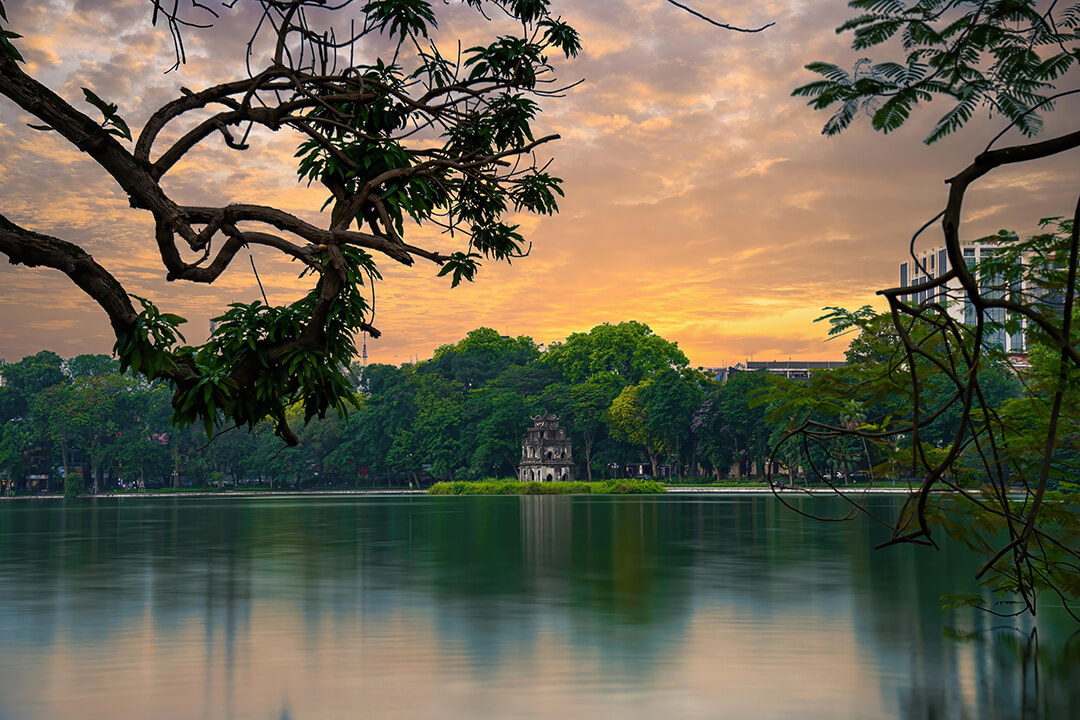
Getting around Hoan Kiem Lake is one of things to do in Hanoi because while walking or cycling around the lake, visitors can admire several key landmarks. One of the most iconic is the The Huc Bridge, a bright red, arched wooden bridge connecting the lakeshore to Ngoc Son Temple, which sits on a small island in the lake. Built in the 19th century, the temple is dedicated to General Tran Hung Dao, a revered hero who defeated the Mongol invaders in the 13th century. The temple is a peaceful place for reflection and a popular spot for photos.
Another prominent feature is the Turtle Tower (Tháp Rùa), located on a small island near the center of the lake. This ancient stone tower stands as a tribute to the turtles that once lived in the lake and symbolize the legendary turtle of the Hoan Kiem legend. The tower, illuminated at night, adds to the lake’s mystical charm.
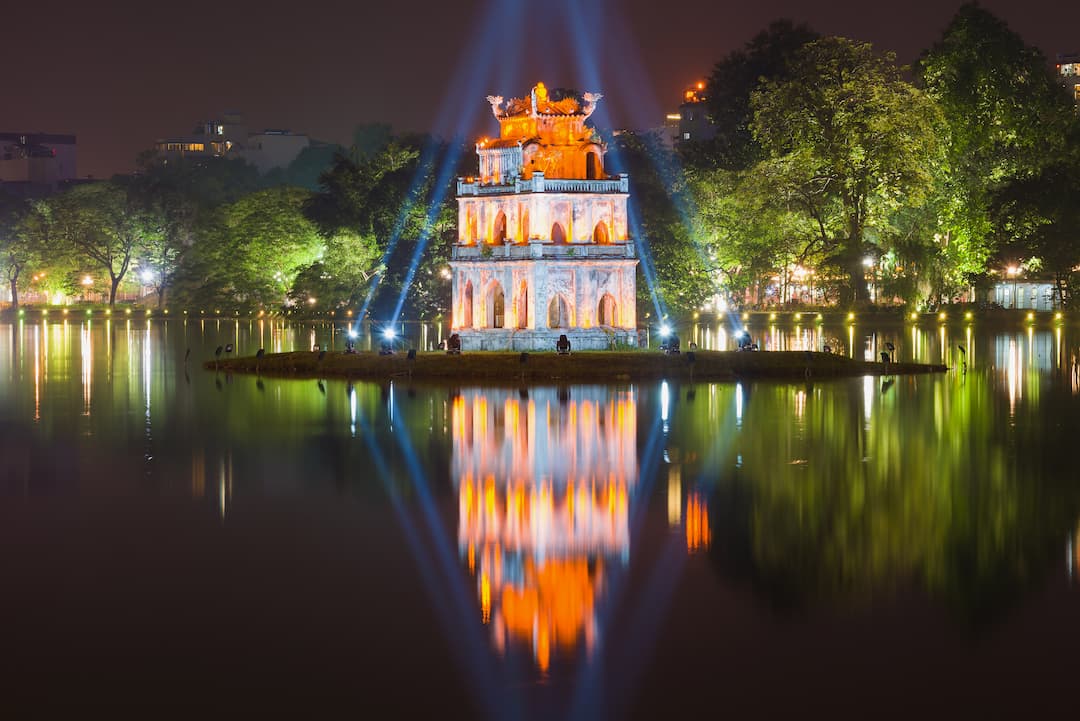
Walking or cycling around Hoan Kiem Lake offers many benefits. It provides a chance to relax and enjoy nature while escaping the fast pace of the city. The 1.7-kilometer path around the lake is ideal for a light workout, surrounded by lush greenery and beautiful views. Locals and tourists alike enjoy the lake for its fresh air, scenic views, and the opportunity to connect with Hanoi’s history and culture. Whether in the early morning or evening, the lake is a perfect spot to unwind and immerse yourself in the beauty of Hanoi
While getting around the lake, you will see some other famous attractions of Hanoi such as Hanoi Old Quarter, Thang Long Water Puppet Theater and Emperor Ly Thai To Monument Statue.
How to find Hoan Kiem Lake, Vietnam
5. Visit Hanoi Old Quarter with 36 Streets and Have Lunch here
Located right next to Hoan Kiem Lake, the Hanoi Old Quarter is one of the most vibrant and culturally rich areas of the city. This bustling neighborhood consists of 36 ancient streets, each historically named after the goods sold there, such as textiles, silver, and bamboo. Today, it remains a thriving center for commerce, offering visitors a blend of traditional and modern Vietnamese life.
As you stroll through the narrow, busy alleys, you’ll be immersed in the unique atmosphere that defines the Old Quarter. Some of the most famous streets include Hang Ma Street, where colorful lanterns and paper products are sold, and Hang Dao Street, known for its vibrant night market and silk goods. Each street has its own distinct character, making exploring the area a fascinating journey through time and culture.
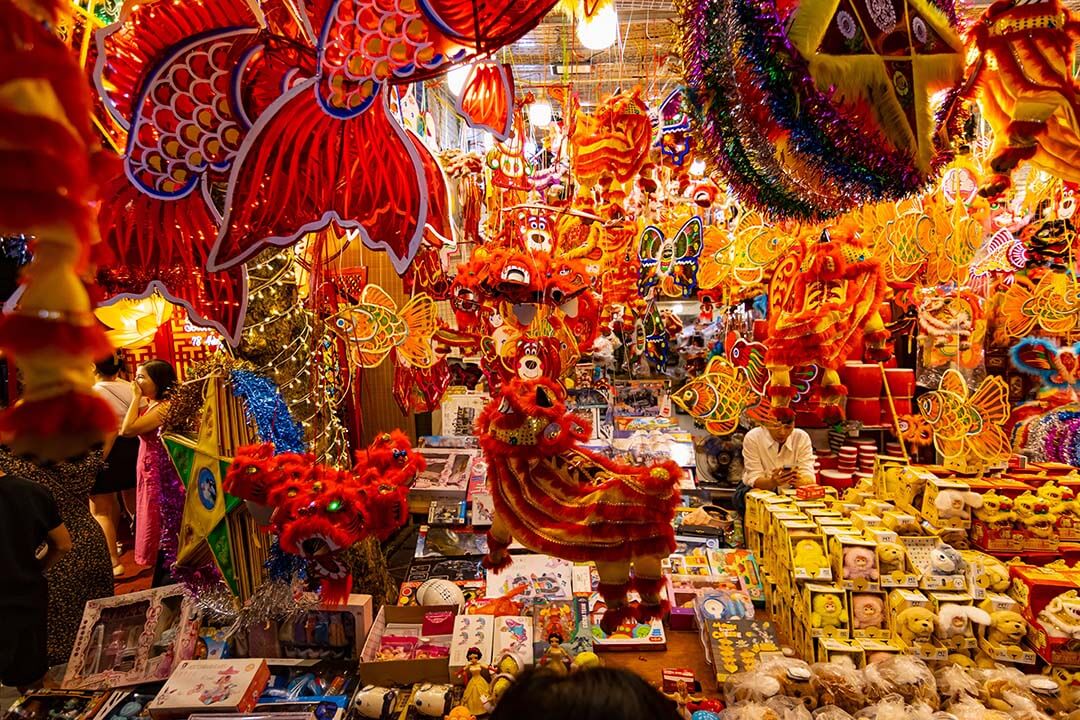
The Old Quarter is also a gastronomic paradise, home to some of the best street food in the city and eating food in Hanoi’s Old Quarter is also things to do in Hanoi. Bun Cha (grilled pork with noodles) is a must-try—succulent pork patties and belly slices are served with fresh herbs, vermicelli, and dipping sauce. Alternatively, experience the famous Cha Ca La Vong, a dish of grilled fish served with dill, peanuts, and rice noodles, cooked right at your table. Both of these dishes offer a taste of authentic Hanoian cuisine.
The Old Quarter is also the location for the popular Hanoi Food Tour, where you can sample a variety of street foods and experience around 80% of Hanoi’s culinary delights. Having lunch here is not just about the food – it’s an opportunity to immerse yourself in the daily life of Hanoi’s people, absorbing the sights, sounds, and flavors that make this city so unique. A visit to the Old Quarter is a perfect way to experience the traditional culture and cuisine of Hanoi in one of its liveliest neighborhoods.
6. Enjoy a Water Puppetry Performance at Thang Long Water Puppet Theatre
A visit to the Thang Long Water Puppet Theatre offers a delightful glimpse into one of Vietnam’s most unique art forms – water puppetry. Originating over a thousand years ago in the rice fields of northern Vietnam, this traditional art form uses puppets to depict scenes from Vietnamese folklore, legends, and rural life. What makes it truly special is that the puppets are controlled by skilled puppeteers hidden behind a screen, making the colorful figures appear to “dance” on water.
Located near Hoan Kiem Lake, the Thang Long Water Puppet Theatre is the perfect place to experience this fascinating cultural performance. The stage is a shallow pool of water, and the puppets, made from lacquered wood, glide across the surface, telling stories of heroic battles, harvest celebrations, and mythical creatures. Accompanied by traditional Vietnamese music, featuring instruments such as the đàn bầu (a one-stringed zither) and đàn tranh (a plucked zither), the performance comes to life with a blend of artistry, history, and entertainment.
Watching a water puppet show will be a highlight in 18 things to do in Hanoi to understand Vietnam’s historical stories. A typical water puppet show lasts about 45 minutes and is suitable for all ages. The theater is one of the most famous venues for this art form, drawing locals and tourists alike. Through these performances, you can learn about Vietnamese folklore, such as the story of the Restored Sword or the legend of the Golden Turtle, while enjoying a unique cultural experience.
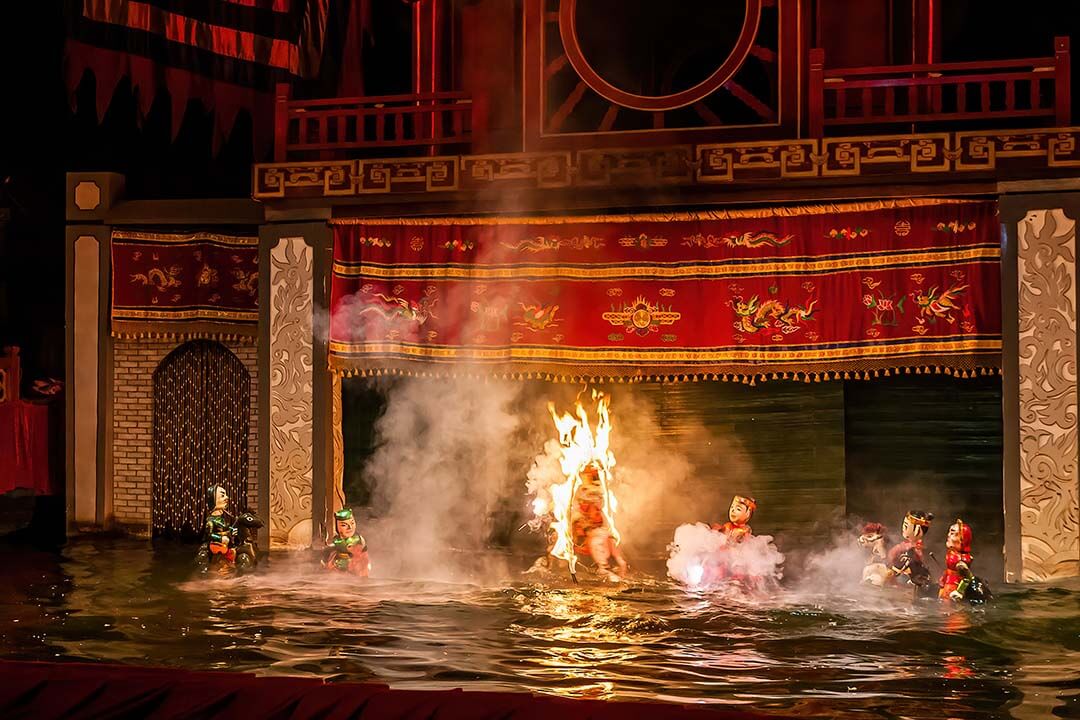
Ticket prices are affordable, typically ranging from $5 to $7, making it a must-do activity for anyone visiting Hanoi. Whether you’re traveling with family or exploring solo, this performance is an enchanting way to dive into the heart of Vietnam’s cultural heritage.
7. Touching Experience at Hoa Lo Prison Relic and More
Located in the heart of Hanoi, at 1 Hoa Lo Street, the Hoa Lo Prison (also known as the “Hanoi Hilton”) is a significant historical site that offers a deep insight into Vietnam’s complex history. Built by the French colonial government in the late 19th century (1896), it was originally used to imprison Vietnamese political prisoners who fought against colonial rule. During the Vietnam War, it was used to hold American prisoners of war (POWs), the most famous being U.S. Senator John McCain.
The prison’s exhibits chronicle its dual history: its role during the French colonial period, where Vietnamese revolutionaries endured harsh conditions, and during the Vietnam War, where American POWs were held. The museum offers a detailed look at life inside the prison, including the brutal punishments endured by Vietnamese prisoners, and features original cells, guillotines, and memorabilia from the war.
One of the most striking features of Hoa Lo Prison is the preserved section of the prison cells, showcasing the extreme conditions under which prisoners were kept. It also highlights the resilience and sacrifices made by Vietnamese revolutionaries. For visitors, it’s an educational and moving experience that vividly portrays the struggles for independence and the complexities of war.
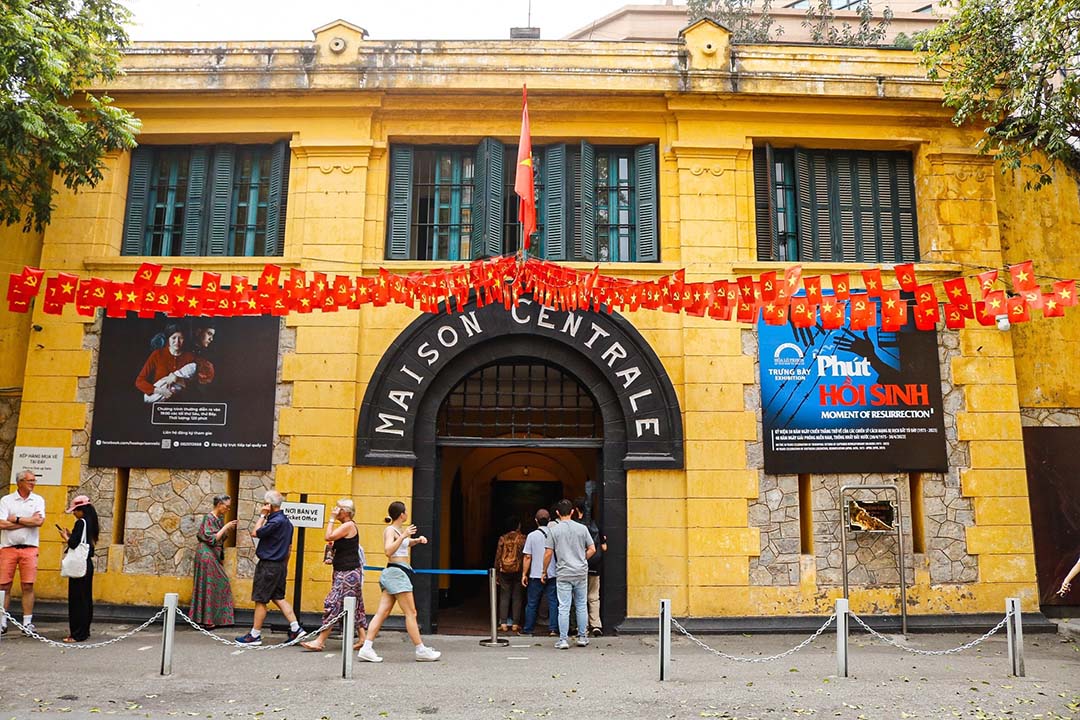
Visiting these sites provides a broader understanding of Vietnam’s history, making Hoa Lo Prison an essential stop for anyone looking to capture the essence of Hanoi’s cultural and historical beauty.
8. Visit Dong Xuan Market – Famous Market in Hanoi
As Hanoi’s largest indoor market, Dong Xuan Market is a bustling hub of activity and a must-visit for those looking to experience the vibrant local culture. Located in the Old Quarter, just a short walk from Hoan Kiem Lake, this multi-level market offers a wide variety of goods, from fresh produce and wholesale goods to souvenirs and traditional handicrafts. Built-in 1889 under French rule, the market has become a key part of Hanoi’s shopping scene and a symbol of the city’s commercial life.
One of the main features of Dong Xuan Market is its diverse range of products. Inside, you’ll find everything from clothing, fabrics, and electronics to traditional Vietnamese souvenirs such as lacquerware, conical hats, and bamboo crafts. The market is also a great place to purchase silk products, often at much lower prices than in high-end stores. Whether you’re looking for a unique gift or just browsing, there’s something for every traveler here.
For food lovers, Dong Xuan Market offers an authentic taste of Hanoi’s street food scene. The market is lined with vendors selling Vietnamese street snacks, like banh cuon (steamed rice rolls) and bun rieu (crab noodle soup). Don’t miss the chance to sample these local delicacies while taking in the lively atmosphere of the market.
A visit to Dong Xuan Market is not complete without some bargaining—a common practice here. Visitors are encouraged to negotiate prices with vendors to get the best deals, especially when buying in bulk or purchasing souvenirs.
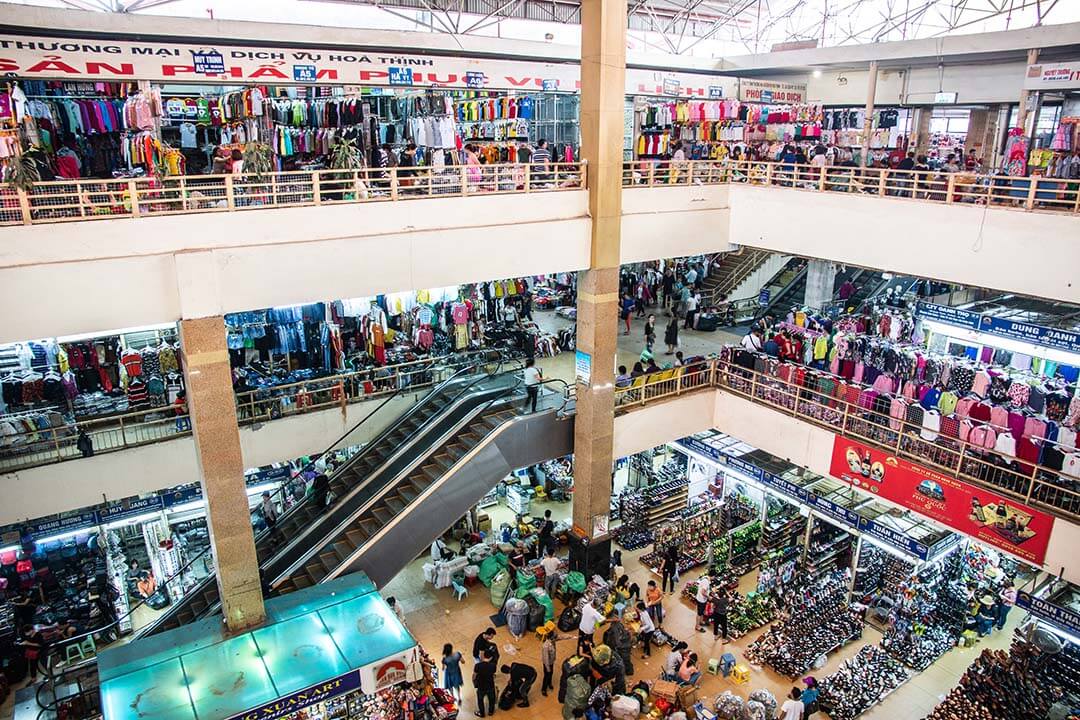
Overall, Dong Xuan Market provides an authentic local shopping experience, combining the energy of a traditional Vietnamese market with a wide variety of goods. Whether you’re shopping for unique items or simply soaking in the atmosphere, it’s a great place to explore the heart of Hanoi’s trade and culture
9. Peruse the Hanoi Night Market
Located in the heart of Hanoi’s Old Quarter, the Hanoi Night Market is a must-visit for anyone looking to experience the city’s lively nightlife and shopping scene. Open every weekend – Friday, Saturday, and Sunday – this bustling market stretches from Hang Dao Street to Dong Xuan Market, providing an exciting blend of commerce, culture, and entertainment. Operating from 18:00 to 23:00, it transforms the streets into a vibrant, colorful space filled with stalls and street performers, making it one of the top destinations for both locals and tourists.
The night market is a street food paradise, offering an incredible variety of Vietnamese snacks and dishes. Stalls line the streets, selling everything from pho cuon (rolled rice noodle sheets) and banh mi to grilled seafood and sweet desserts. It’s the perfect place to sample local street food, try traditional snacks, and enjoy a casual evening meal in the heart of the city. The delicious aromas and sights will guide you through the market as you explore the culinary wonders of Hanoi.
Aside from food, the Hanoi Night Market is an ideal spot to pick up souvenirs, clothing, accessories, and electronics. You’ll find a wide range of affordable goods, and bargaining is common, so don’t hesitate to negotiate with vendors to get the best prices. The market offers everything from fashion items to handmade crafts and traditional Vietnamese gifts like silk scarves and bamboo products.
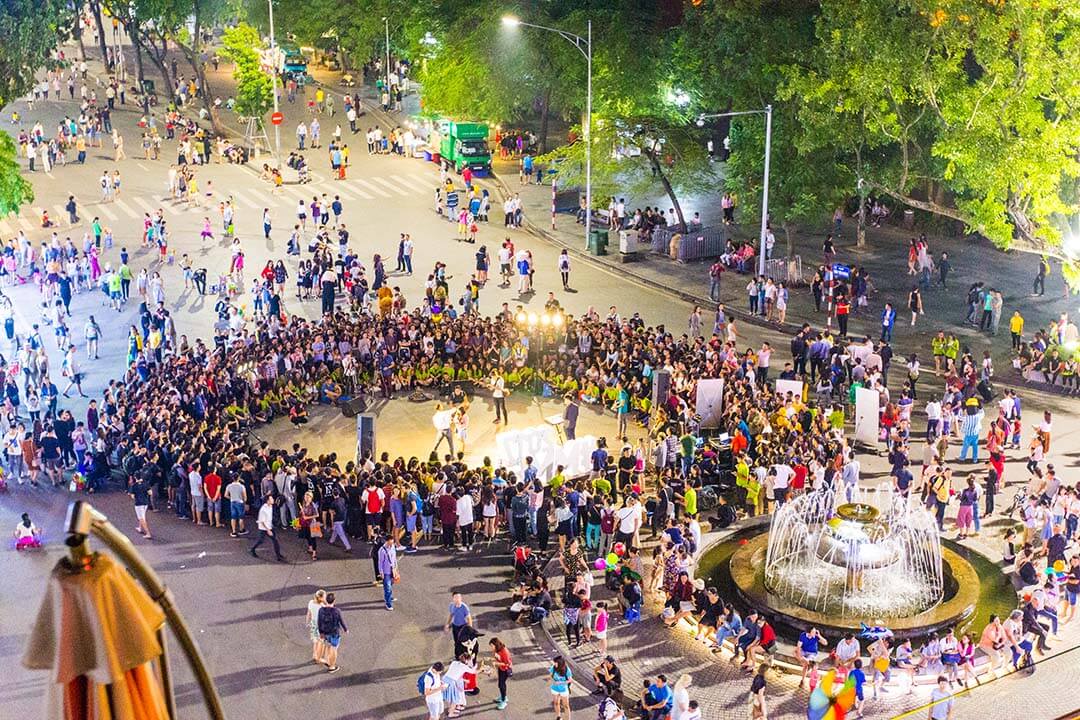
Whether you’re looking to shop for unique gifts or just enjoy the lively atmosphere, the Hanoi Night Market is the perfect place to experience the vibrant nightlife of Hanoi. With street performances, food stalls, and endless shopping options, it’s an evening of fun and exploration in the heart of the Old Quarter
10. Indulge in Hanoi Cuisine
Hanoi is not just the political and cultural capital of Vietnam, but also a culinary hub that reflects the diverse flavors from across the country. As mentioned above, Hanoi is a place with a rich history of Vietnamese people, popular dishes from all parts of the country are present here at a rate of up to 90%. Beyond the iconic dishes like Bun Rieu Cua, Nem Ran, and Xoi Xeo, Hanoi offers an array of other delightful meals that every food lover should explore. Here are five other notable dishes to enjoy in the city:
- Bun Thang (Mixed Vermicelli Soup):
Bun Thang is a delicate vermicelli soup that features thinly sliced chicken, omelette strips, and pork on top of a light broth. The broth is made by simmering bones, dried shrimp, and squid for hours to create a fragrant and clear soup. Bun Thang is traditionally garnished with herbs like coriander and served with shrimp paste and chili. One of the best places to enjoy this dish is at Bun Thang Ba Duc. - Cha Ca (Grilled Fish with Dill and Turmeric):
A signature dish in Hanoi, Cha Ca features white fish marinated with turmeric and grilled, then sautéed with dill and green onions. It is typically served on a sizzling pan at your table and eaten with vermicelli noodles, peanuts, and shrimp paste. The experience of grilling and eating it fresh makes it a must-try. Head to Cha Ca La Vong, one of the most famous spots for this dish, to savor it. - Banh Cuon (Steamed Rice Rolls):
Banh Cuon is made from thin, delicate rice sheets that are steamed and then filled with minced pork and wood ear mushrooms. The rolls are served with a side of nuoc cham (fish sauce) for dipping and garnished with fried shallots and herbs. It’s a light and flavorful dish often enjoyed for breakfast. Try it at Banh Cuon Ba Hoanh for an authentic experience. - Bun Dau Mam Tom (Fried Tofu and Noodles with Shrimp Paste):
This dish consists of crispy fried tofu, fresh vermicelli noodles, and a variety of herbs served alongside mam tom (fermented shrimp paste). The shrimp paste is often mixed with lime juice, chili, and sugar to create a pungent but flavorful dipping sauce. It’s a popular street food that you can find at Bun Dau Mam Tom Hang Khay. - Banh Goi (Fried Pillow Cake):
Banh Goi is a crispy fried pastry stuffed with pork, glass noodles, mushrooms, and quail eggs. Its name translates to “pillow cake” due to its shape resembling a pillow. These cakes are best enjoyed hot and dipped in nuoc cham with a side of fresh herbs. You can find some of the best Banh Goi at Quan Goc Da.
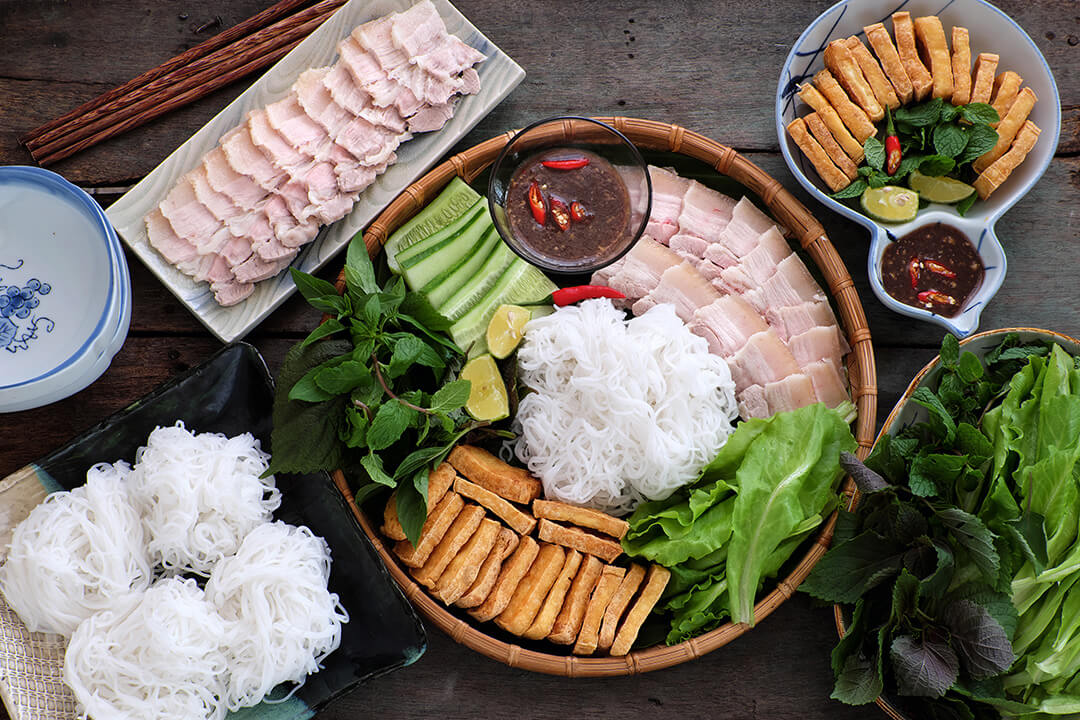
Exploring Hanoi’s food scene is a journey through the rich history and culture of Vietnam, with dishes that highlight the use of fresh ingredients and bold flavors. Don’t miss the chance to indulge in these local specialties at some of the city’s most famous eateries.
11. Join the Entertainment of Hanoi Nightlife
Hanoi’s nightlife offers a diverse array of experiences, catering to all tastes. Whether you’re looking for a lively atmosphere or a more relaxed setting, the city has something for everyone. One of the most famous spots for night entertainment is Ta Hien Street, often referred to as Hanoi’s “Beer Street”. Here, you can grab a cold glass of Bia Hoi—Vietnam’s famous fresh draft beer—and mingle with both locals and tourists in an energetic, open-air environment. The street comes alive at night, with people sitting on small stools enjoying cheap drinks, street food, and vibrant conversations. It’s an ideal spot for those who love to socialize and experience Hanoi’s youthful energy.
For those seeking a more laid-back evening, Hanoi’s rooftop bars and live music venues are perfect. Head to popular rooftops like The Summit Lounge or Skyline Bar, where you can sip on a cocktail while enjoying stunning panoramic views of Hanoi’s skyline and iconic landmarks like Hoan Kiem Lake and the Red River. These spots offer a more refined atmosphere, ideal for unwinding after a day of sightseeing.
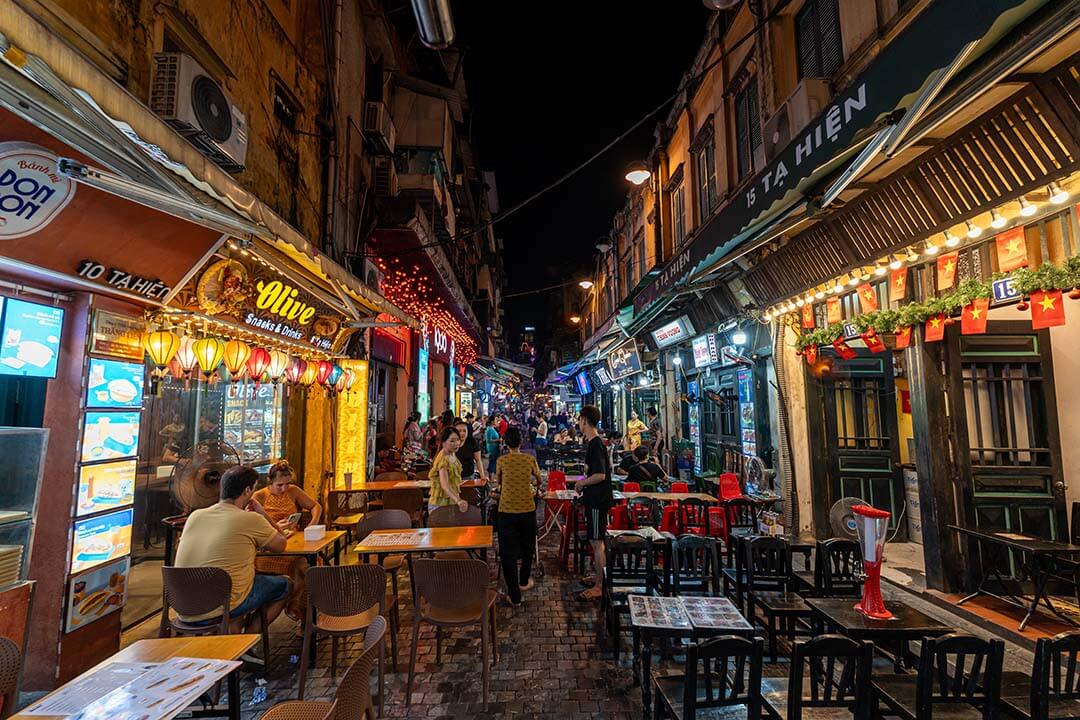
If you love music, Hanoi’s live music venues like The Jazz Club Hanoi or Polite & Co provide the perfect backdrop for a more intimate evening. Here, you can enjoy live performances from local and international artists, with genres ranging from jazz to rock and traditional Vietnamese music.
No matter your preference, Hanoi’s nightlife offers a rich blend of fun, relaxation, and culture, making it a must-experience aspect of the city’s vibrant social scene. Whether you’re looking to party on Ta Hien Street or chill at a rooftop bar, there’s something for everyone to enjoy.
12. Enjoy the Sunrise and Relaxation at West Lake
West Lake (Hồ Tây) is the largest freshwater lake in Hanoi, covering an impressive area of around 500 hectares (1,235 acres). Its vast expanse offers a peaceful retreat from the city’s bustling streets, making it a popular destination for both locals and visitors. With a 17-kilometer-long lakebank, West Lake provides a picturesque setting for outdoor activities and is especially known for its breathtaking sunrises.
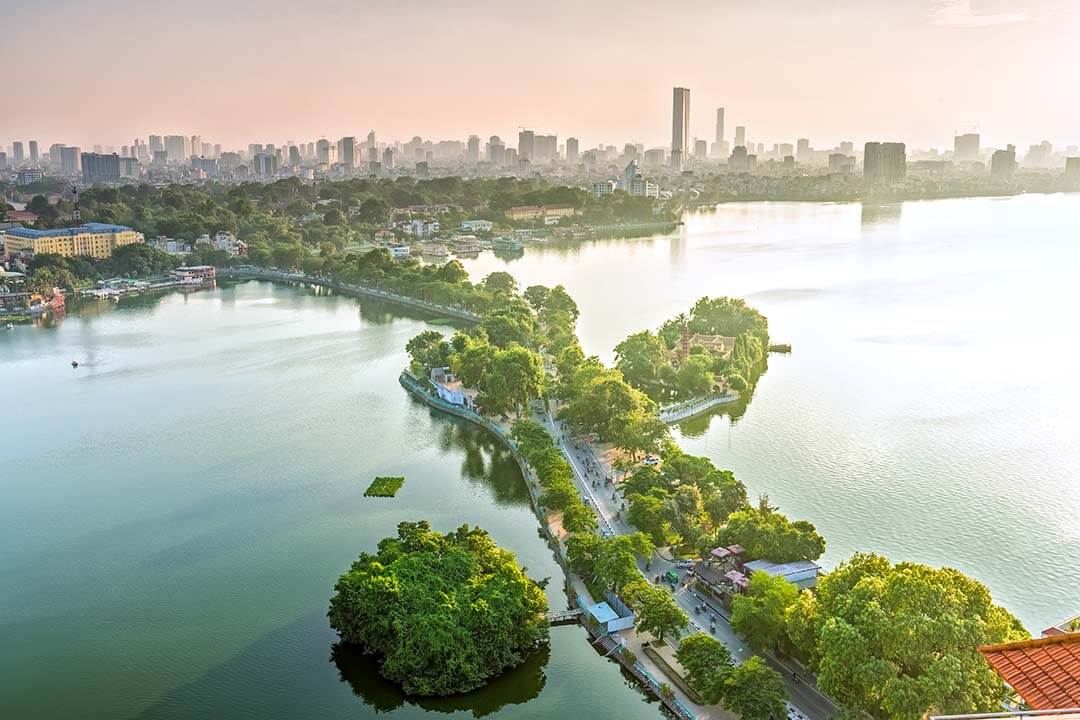
One of the best ways to enjoy the beauty of West Lake is by taking an early morning walk or bike ride along the lake’s perimeter. The calm, mirror-like waters reflect the soft hues of the rising sun, creating a tranquil atmosphere that’s perfect for relaxation and photography. As the day begins, you’ll see locals jogging, cycling, or practicing Tai Chi near the lake.
West Lake offers a range of activities for visitors. Boat rides are a favorite, allowing you to leisurely explore the lake while taking in the surrounding scenery, including ancient temples and pagodas that dot the area, such as the iconic Tran Quoc Pagoda—Hanoi’s oldest Buddhist temple. If you’re looking for a peaceful spot to unwind, there are plenty of lakeside cafes where you can enjoy a cup of Vietnamese coffee while admiring the stunning views
How to find West Lake:
13. Explore Vietnamese History at the Temple of Literature, Thang Long Imperial Citadel, and One Pillar Pagoda
Hanoi is steeped in history, and visiting its historical treasures is a should for anyone looking to understand the rich cultural heritage of Vietnam. The Temple of Literature (Văn Miếu), founded in 1070, is Vietnam’s first national university and a tribute to Confucian education. This tranquil site features beautifully landscaped courtyards, lush gardens, and stunning pavilions, making it a peaceful oasis in the city. Visitors can admire intricate stone steles honoring scholars and take a leisurely stroll through the picturesque grounds, which reflect the intellectual spirit of ancient Vietnam.
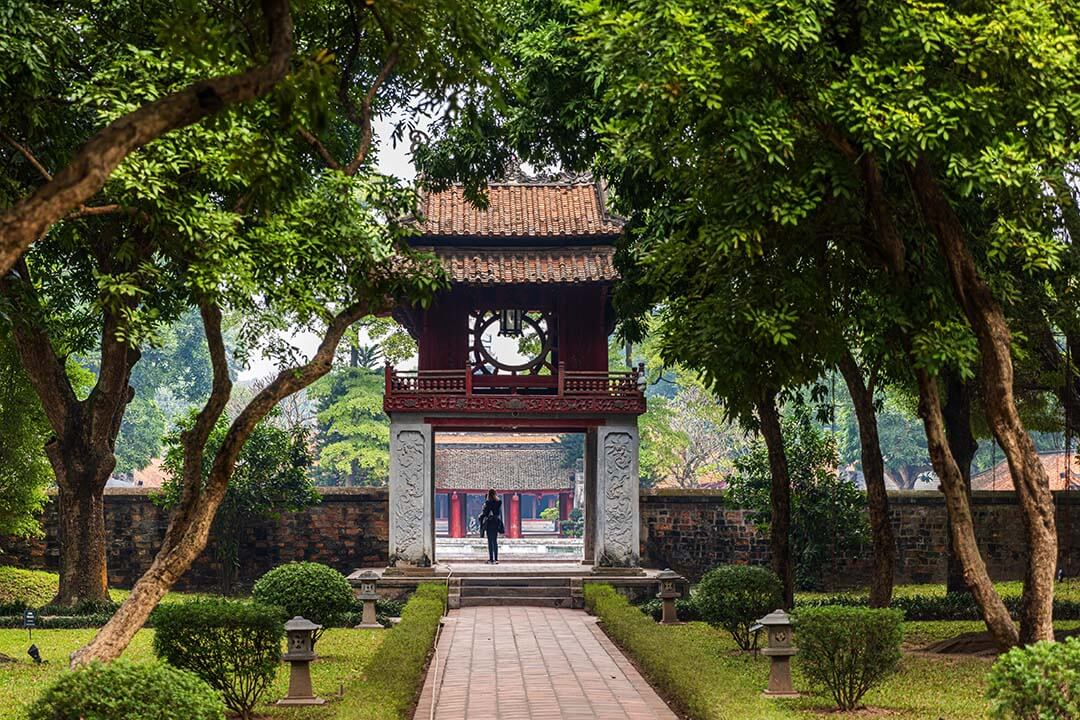
Just a short distance away lies the Thang Long Imperial Citadel (Hoàng Thành Thăng Long), a UNESCO World Heritage Site. This sprawling complex dates back to the 11th century and served as the political center of Vietnam for centuries. The citadel features well-preserved structures, including the D67 bunker, which provides insight into Vietnam’s military history, and the North Gate, a remarkable example of ancient Vietnamese architecture. The site is rich in historical significance, showcasing the various dynasties that ruled the region and their contributions to Vietnamese culture and governance.
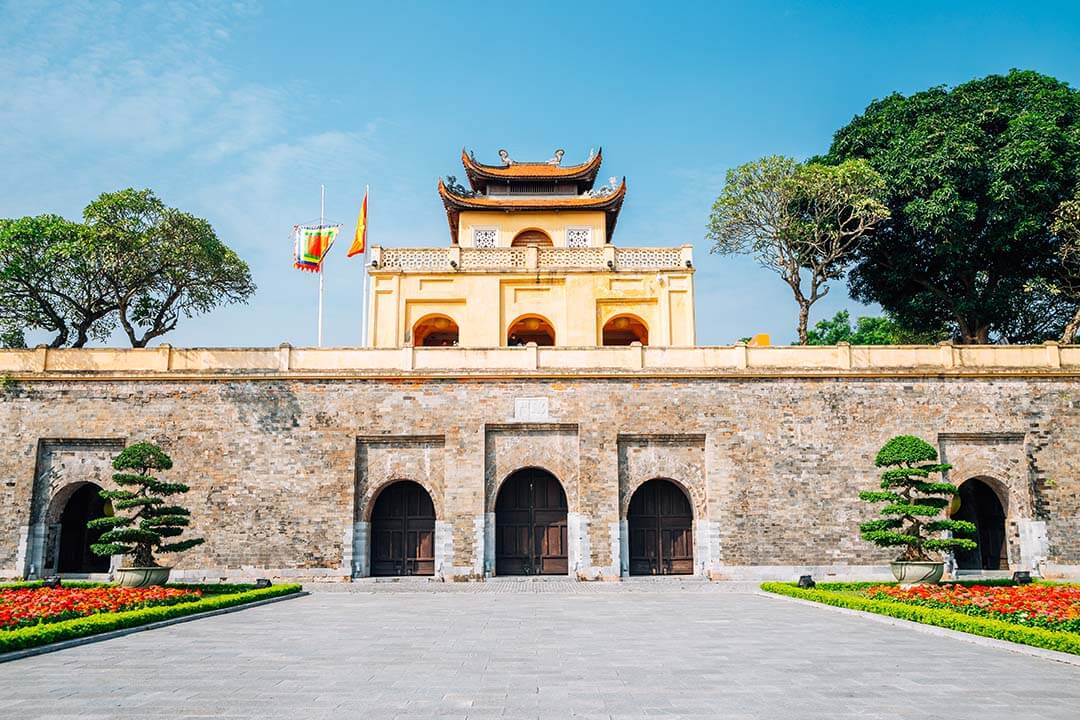
Nearby, you’ll find the One Pillar Pagoda (Chùa Một Cột), one of Vietnam’s most iconic architectural marvels. Constructed in 1049, this unique wooden structure stands on a single stone pillar, symbolizing a lotus blossom rising from the water. It is a revered Buddhist site and attracts many visitors who come to admire its distinctive design and serene setting. The pagoda is dedicated to Avalokiteshvara, the Goddess of Mercy, and is often associated with the wish for fertility.
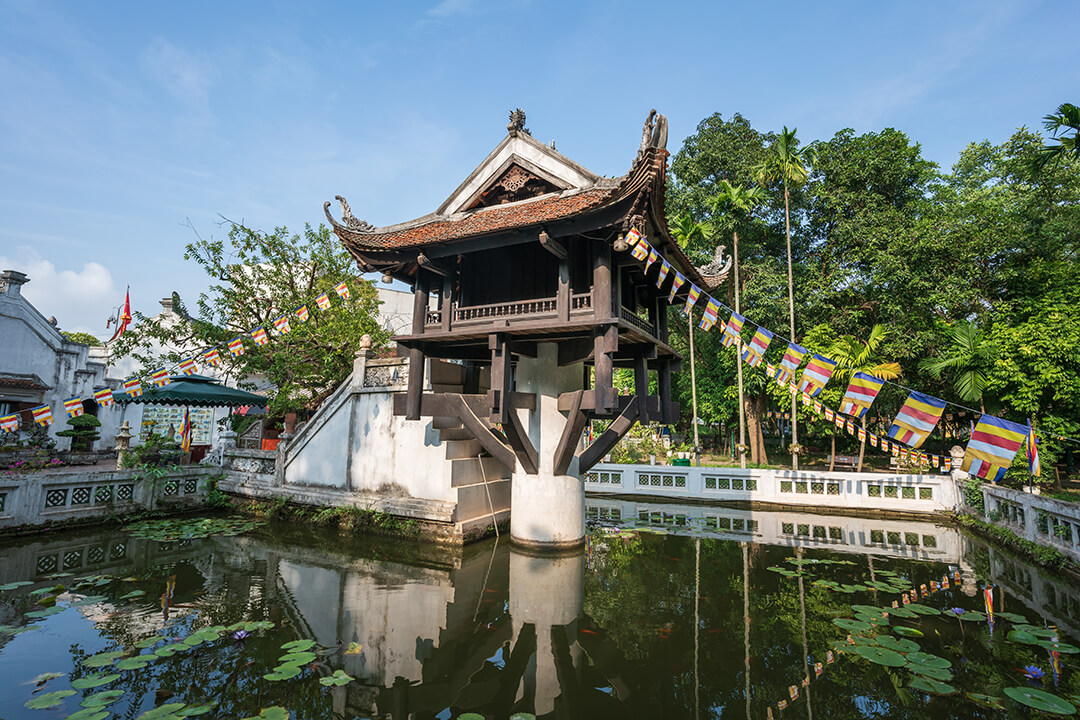
Exploring these historical landmarks offers a profound understanding of Vietnam’s cultural evolution and provides a glimpse into the country’s past. Each site encapsulates a different aspect of Vietnamese history, making them essential stops on your journey through Hanoi.
14. Visit French Colonial Architecture Buildings in Hanoi
Hanoi’s French colonial architecture is a captivating reflection of its historical past and cultural fusion. As you wander through the city, you’ll encounter stunning structures that showcase the elegance and grandeur of this architectural style, which flourished during the late 19th and early 20th centuries.
One of the most iconic landmarks is the Hanoi Opera House, an impressive building designed by French architect Paul Gardès in 1911. Modeled after the Palais Garnier in Paris, the opera house features ornate facades, elegant columns, and beautiful interiors. It serves as a cultural hub, hosting various performances, including opera, ballet, and concerts, making it a must-visit for both architecture enthusiasts and art lovers. The surrounding area is lively, often filled with local vendors and musicians, adding to the vibrant atmosphere.
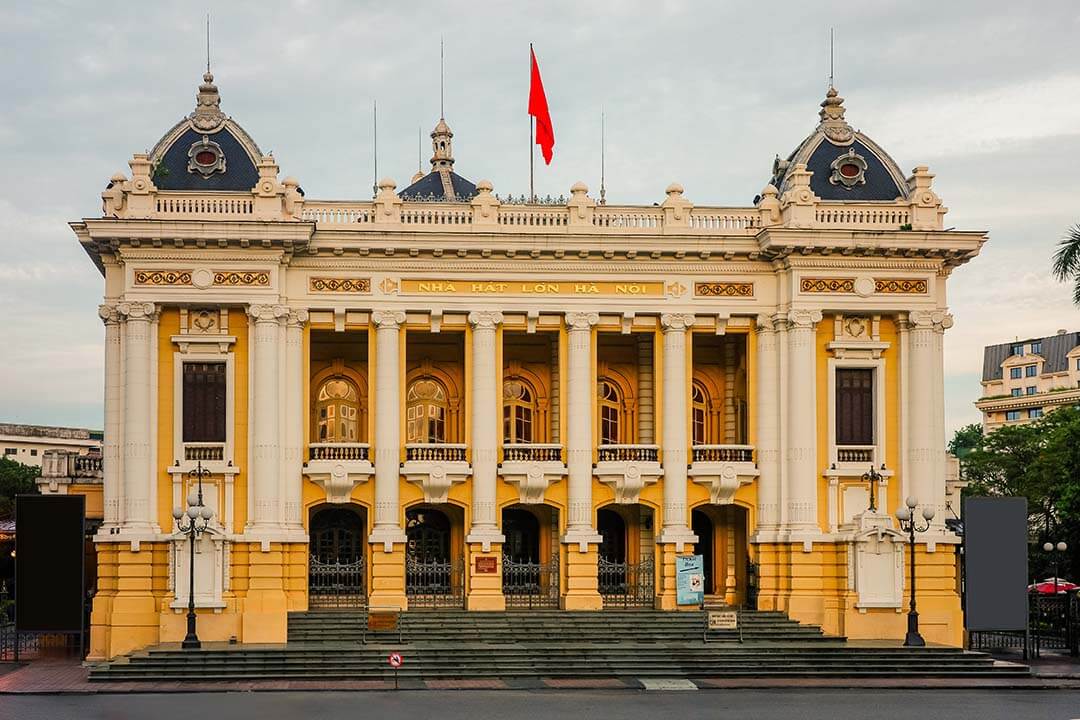
Another architectural building is St. Joseph’s Cathedral, located in the heart of the Old Quarter. This stunning Gothic-style church was completed in 1886 and is one of the oldest churches in Vietnam. With its tall spires, arched windows, and intricate stonework, the cathedral offers a unique contrast to the bustling streets of Hanoi. It is not only a place of worship but also a popular spot for visitors seeking to admire its stunning architecture and experience the tranquil ambiance. The area around the cathedral is lively, with quaint cafés and shops, making it a perfect place to relax and soak in the local culture.
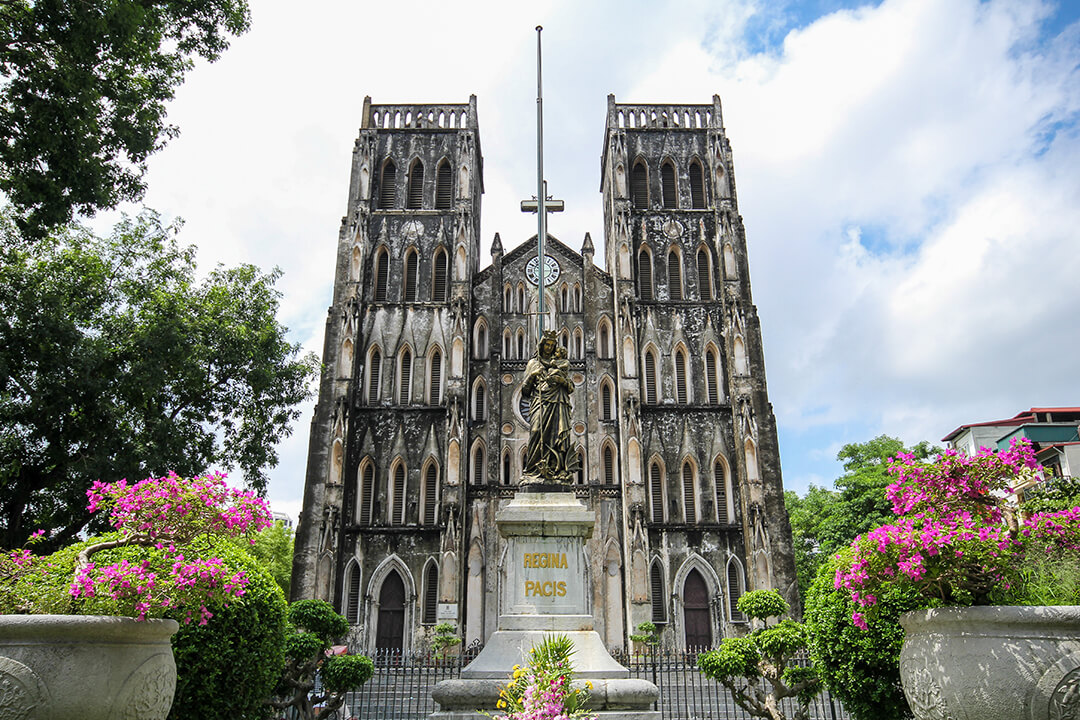
Exploring these architectural works allows you to appreciate the historical significance of French colonial influence in Hanoi. Each building tells a story of the past and offers a glimpse into the city’s transformation over the years, making them essential stops on your journey through Hanoi’s rich heritage. Whether you’re an architecture aficionado or simply looking to capture beautiful photographs, these landmarks are sure to leave a lasting impression
15. Indulge in a Hanoi Cooking Class
If you’re looking to take a piece of Hanoi home with you, joining a local cooking class is a fantastic way to immerse yourself in Vietnamese culinary culture. These classes often begin with a market tour, where you’ll visit bustling local markets to select fresh ingredients, including aromatic herbs, vibrant vegetables, and proteins like pork, chicken, or seafood. This firsthand experience not only introduces you to local produce but also gives you insight into the key components of Vietnamese cuisine.
In the cooking class, experienced chefs will guide you through the preparation of authentic Vietnamese dishes, such as Pho and Nem (spring rolls). Pho is a flavorful noodle soup made with beef or chicken, accompanied by fresh herbs and spices, while Nem features delicate rice paper rolls filled with seasoned meat and vegetables. You’ll learn various cooking techniques, from balancing flavors to mastering traditional methods of preparation, ensuring that you can recreate these dishes back home.
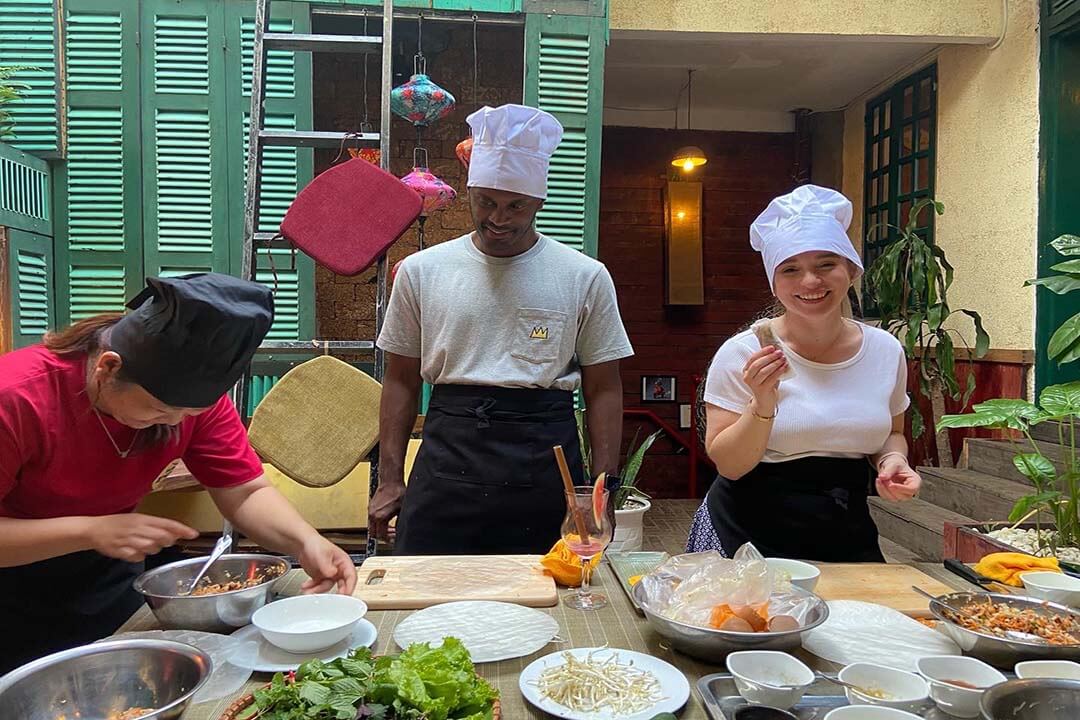
Most classes emphasize a hands-on approach, allowing you to actively participate in every step of the cooking process, making it a fun and interactive experience. As you cook, you’ll also discover fascinating stories about the history and significance of each dish, deepening your appreciation for Vietnamese food culture.
Many cooking classes also include a communal meal at the end, where you can savor the fruits of your labor alongside fellow participants. Sharing these dishes in a relaxed, friendly atmosphere enhances the experience and allows you to connect with other food lovers. With prices typically ranging from $30 to $60, this culinary adventure is an excellent value for the skills and memories you’ll gain. By the end of the class, you’ll not only have learned new recipes but also created lasting connections with local chefs and fellow travelers, making it a highlight of your trip to Hanoi
16. Rent and Wear Ao Dai – Traditional Vietnamese Clothing
Embrace the charm of Vietnamese culture by renting and wearing an Ao Dai, the traditional dress of Vietnam. This elegant outfit consists of a long tunic that flows gracefully over fitted trousers, often made from colorful silk or lightweight fabrics. Wearing an Ao Dai not only allows you to connect with Vietnam’s rich heritage but also provides a stunning backdrop for memorable photos around Hanoi’s iconic sites.
In Hanoi, several rental shops offer a variety of Ao Dai styles and colors, allowing you to choose one that reflects your personality and taste. Whether you prefer a classic white Ao Dai or a more vibrant version adorned with intricate patterns, you’re sure to find the perfect ensemble. Many rental shops also provide fitting services, ensuring that the outfit complements your figure perfectly. Prices typically range from $10 to $30, depending on the style and rental duration, making it an affordable way to experience Vietnamese culture.

Once you’re dressed in the Ao Dai, venture out to explore the city’s breathtaking landmarks, such as Hoan Kiem Lake, the Temple of Literature, or the Old Quarter. The Ao Dai’s flowing design not only enhances your grace as you stroll through the streets but also allows you to blend beautifully with the cultural backdrop. Capture stunning photographs against the picturesque scenery, creating lasting memories of your time in Hanoi.
Wearing an Ao Dai will enhance your experience, as locals often respond with smiles and admiration. It’s a unique opportunity to connect with the culture and showcase the beauty of traditional Vietnamese attire. Renting an Ao Dai is not just about dressing up; it’s about embracing the spirit of Vietnam and creating unforgettable moments during your travels
17. Understand More About Vietnam’s Ethnic Groups Through the Vietnam Museum of Ethnology
The Vietnam Museum of Ethnology is a must-visit destination for anyone looking to delve deeper into Vietnam’s rich cultural tapestry, showcasing the country’s 54 ethnic groups. Located in a spacious area just a short drive from the city center, the museum features thoughtfully curated exhibits that highlight the unique traditions, customs, and lifestyles of these diverse communities.
Visiting the Museum of Ethnology is nice activity of things to do in Hanoi to better understand Vietnam’s national identity. As you enter the museum, you’ll find a variety of traditional costumes displayed, allowing you to appreciate the vibrant colors and intricate designs that reflect each ethnic group’s identity. The museum also features a collection of tools, crafts, and artifacts, providing insight into the daily lives of different groups, from farming and fishing to hunting and weaving. Interactive displays and informative panels enhance your understanding, offering context about the historical and social significance of these items.
One of the highlights of the museum is the outdoor exhibition area, which showcases traditional houses from various ethnic groups. You can explore these life-sized replicas and gain insight into the architectural styles and living conditions of the different communities. This immersive experience allows visitors to visualize the cultural diversity that exists within Vietnam.
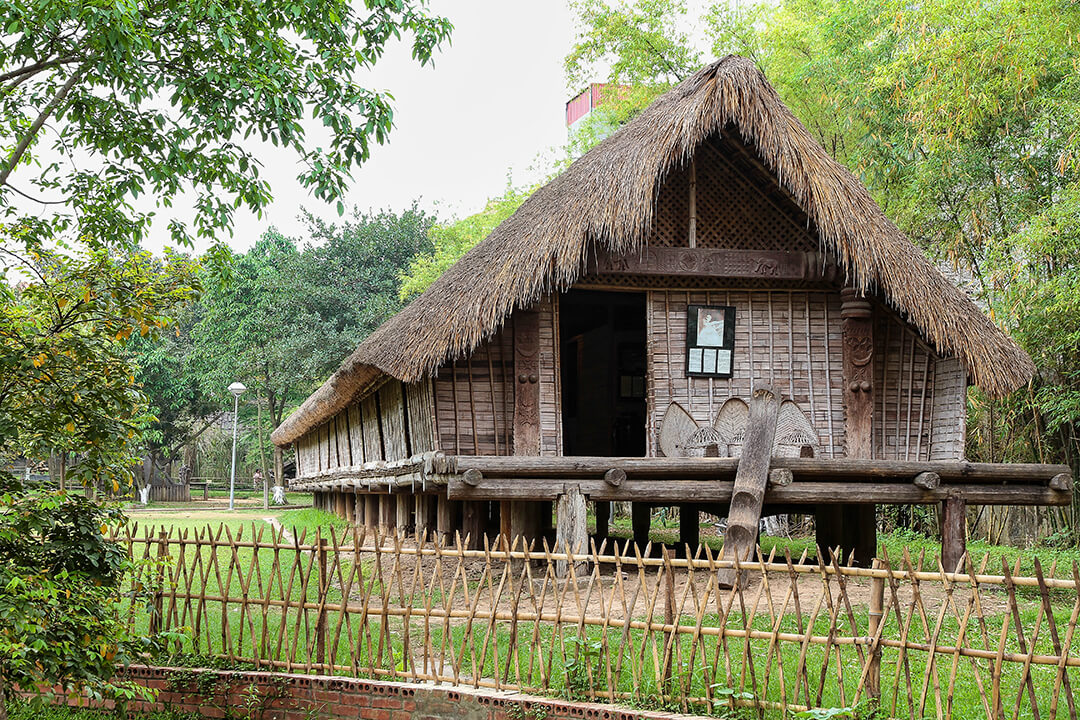
In addition to the permanent exhibits, the museum often hosts special events, workshops, and cultural performances, giving visitors an opportunity to engage directly with the traditions being showcased. You might witness live demonstrations of traditional crafts or enjoy performances of ethnic music and dance.
Visiting the Vietnam Museum of Ethnology is an enriching experience that not only broadens your knowledge of Vietnam’s ethnic diversity but also fosters appreciation for the unique contributions each group has made to the nation’s cultural heritage. With an entrance fee of around $1 to $2, it offers great value for the depth of understanding and enjoyment it provides, making it a valuable stop on your journey through Hanoi.
18. Learn About Pottery at Bat Trang Pottery Village
Just a 30-minute drive from Hanoi, Bat Trang Pottery Village is a captivating destination for anyone interested in traditional Vietnamese craftsmanship. Renowned for its exquisite ceramics, Bat Trang has a history dating back over 700 years, making it one of the oldest pottery villages in Vietnam. The village is nestled along the Red River, providing the ideal clay-rich environment for pottery production.
Visitors to Bat Trang can explore numerous workshops and showrooms that showcase a wide array of beautiful ceramics, from intricately painted vases to functional tableware. The craftsmanship on display reflects the unique styles and techniques that have been passed down through generations. As you stroll through the village, you’ll have the opportunity to witness local artisans at work, skillfully molding and painting their creations.
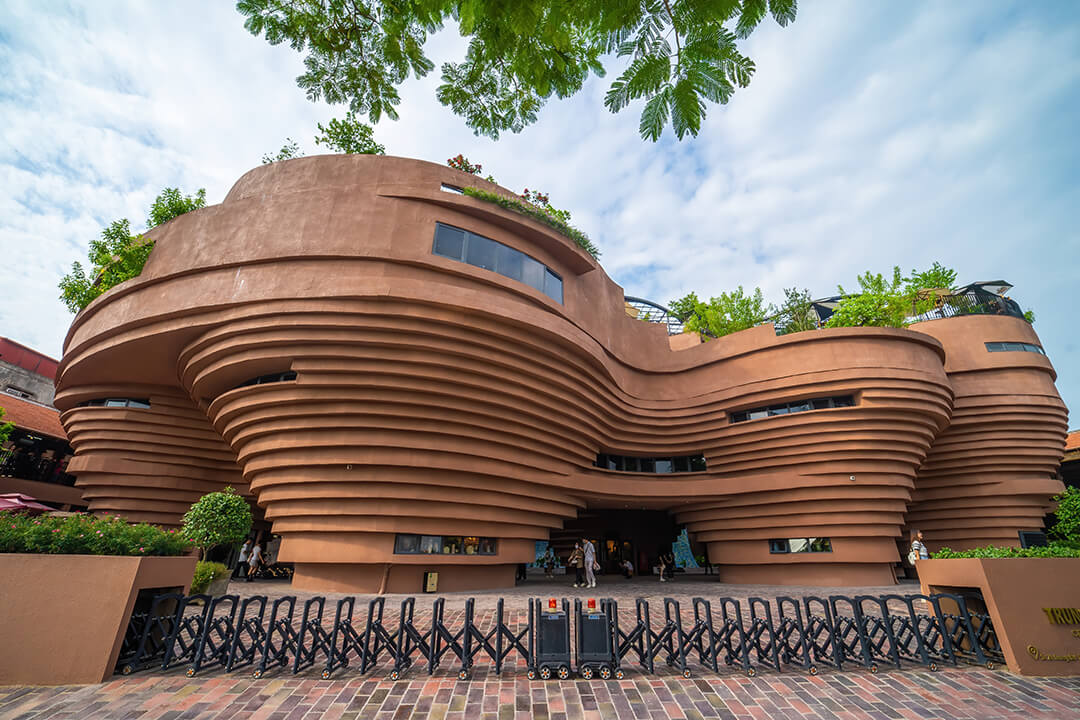
For those eager to try their hand at pottery, many workshops offer hands-on classes where you can learn the basics of pottery making. Guided by experienced artisans, you’ll have the chance to shape your own pieces and experiment with different glazing techniques. This interactive experience not only provides a deeper appreciation for the art of pottery but also allows you to take home a personal souvenir from your visit.
Travel Tips for Visiting Hanoi
To have a good experience in Hanoi, you should know some tips, below are 4 tips that you will need during your visit to Hanoi.
1. Best Time to Visit Hanoi
The ideal time to visit Hanoi is during the spring (March to April) or autumn (September to November). During these months, the weather is typically cool and pleasant, making it perfect for sightseeing and outdoor activities. You can enjoy clear skies, mild temperatures, and vibrant scenery, especially with the blooming flowers in spring and the colorful autumn leaves.
2. How to Get to Hanoi
Hanoi is accessible via Noi Bai International Airport, which receives flights from major cities around the world. The airport is approximately 30 kilometers from the city center, and you can easily reach the city by taxi, shuttle bus, or ride-hailing services. If you’re traveling domestically, Vietnam has an efficient network of trains and buses connecting Hanoi with other cities, making it easy to include the capital in your itinerary.
3. How to Get Around Hanoi
Navigating Hanoi is convenient thanks to various transportation options. You can use motorbike taxis (like GrabBike) for quick rides, public buses for affordable travel, and cyclos (pedicabs) for a unique experience as you explore the city at a leisurely pace. For those who prefer to soak in the atmosphere, walking is highly recommended, especially in the Old Quarter, where narrow streets and bustling markets await discovery.
4. How Many Days Should I Spend in Hanoi?
To fully experience the 18 activities mentioned, plan for a stay of about 4-5 days. This allows you to explore each attraction without feeling rushed and enjoy local cuisine and culture. However, if you’re short on time, a 2-day itinerary can still cover many key highlights, including Hoan Kiem Lake, the Old Quarter, and a visit to the Temple of Literature. Prioritize your must-see spots and enjoy the vibrant energy of the city at your own pace


